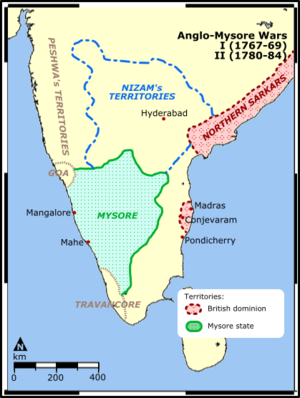| Battle of Tiruvannamalai | |||||||
|---|---|---|---|---|---|---|---|
| Part of the Anglo-Mysore Wars | |||||||
 A map of the war theatre | |||||||
| |||||||
| Belligerents | |||||||
|
|
| ||||||
| Commanders and leaders | |||||||
|
|
| ||||||
The Battle of Tiruvannamalai is one of the two successful battles fought by the Madras Army in the Carnatic along with the Battle of Chengam. It was fought on 25 September 1767 between the allied forces lead by the East India Company and troops of Hyder Ali. The allied forces of the English army was led by Colonel Smith.
Background[]
During the eighteenth century, the Indian subcontinent under the control of the Mughul Empire lost its territory with the death of Emperor Aurangzeb in 1707. The empire split among viceroys and other local rulers with bitter fight among each other.[1] In the 1740s and 1750s French and British colonial companies became more active in these local conflicts, and by the Third Carnatic War (1757–1763), the British gained Bombay, Madras, and Calcutta and emerged single largest among other colonial powers. Their eastern holdings at Madras were strongly influenced by treaties with the Nawab of Carnatic, Muhammed Ali Khan Wallajah, whose territory surrounded Madras. The other major powers in the east were the Nizam of Hyderabad, formerly a viceroyalty of the Mughul Empire but declared independent in the 1720s, held in the 1760s by Asaf Jah II, and the Sultanate of Mysore, which occupied the high plains between the Eastern and Western Ghats, the mountain ranges separating the coastal plains of India from the interior. Nominally ruled by the Wodeyar dynasty, control of Mysore had in 1761 come into the hands of Hyder Ali, a Muslim military leader.[2] Each of these powers intrigued with and against the others, and sought to draw the power of the French and British colonial companies to serve their objectives. The colonial powers sought to influence the local powers to gain either direct control of territory, or the revenues from territory nominally controlled by a local ruler beholden to them for financial and military support. Since European military training was significantly better than local practices, small numbers of disciplined European or European-trained forces could defeat significantly larger Indian armies composed mainly of poorly trained infantry and cavalry.[3]
The Battle[]
The Battle of Tiruvannamalai is one of the two successful battles fought by the Madras Army in the Carnatic along with the Battle of Chengam.[4] The allied forces of Hyder Ali were invaded by the British Army under Colonel Smith in Chengam on 3 September 1767. The English Army had an upper hand in the battle. A second battle, the Battle of Tiruvannamalai took place on 25 September 1767 that lasted 2 days.[5]
It was fought on 25 September 1767 between the troops of East India Company and troops of Hyder Ali. The allied forces of the English army was led by Colonel Smith.[4] The Nawab's army lost 4,000 men and 64 guns in the battle. After a brief tussle for a couple of years, Tipu Sultan captured Tiruvannamalai.[5]
After losing the battle, Hyder Ali offered peace with the British Army, which was denied. He then collated all his army and had another fight that led him close to capture of Madras within a distance of 5 miles. The British had a peace treaty during April 1769 with the status quo ante bellum. The treaty also laid terms for mutual aid and end of defensive alliance.[6]
Notes[]
- ↑ Bowring 1899, pp. 19–23
- ↑ Bowring 1899, p. 33
- ↑ Duff 1878, pp. 607–608
- ↑ 4.0 4.1 Tritton 2013, pp. 90-91
- ↑ 5.0 5.1 Illustrated guide to Southern Railway 1900, p. 304
- ↑ Tucker 2009, p. 794
References[]
- Bowring, Lewin (1899). Haidar Alí and Tipú Sultán, and the Struggle with the Musalmán Powers of the South. Oxford: Clarendon Press. OCLC 11827326. http://books.google.com/books?id=v80NAAAAIAAJ.
- Duff, James Grant (1878). History of the Mahrattas, Volume 1. London and Bombay: Times of India. OCLC 23116888. http://books.google.com/books?id=tYscAAAAMAAJ&pg=PA652#v=onepage&f=false.
- Tritton, Alan (2013). When the Tiger Fought the Thistle: The Tragedy of Colonel William Baillie of. The Radcliffe Press. ISBN 9780857722959. http://books.google.com/books?id=1yMBAwAAQBAJ&pg=PA90&dq=battle+of+tiruvannamalai&hl=en&sa=X&ei=A9dSU5mCA_HNsQSLloHABw&ved=0CC0Q6AEwAA#v=onepage&q=battle%20of%20tiruvannamalai&f=false.
- Illustrated guide to the South Indian Railway: including the Mayavaram-Mutupet, and Peralam-Karaikkal railways. Higginbotham's. 1900. p. 217. http://books.google.com/books?id=irg2AAAAMAAJ&pg=PA304&dq=battle+of+tiruvannamalai&hl=en&sa=X&ei=A9dSU5mCA_HNsQSLloHABw&ved=0CDMQ6AEwAQ#v=onepage&q=battle%20of%20tiruvannamalai&f=false.
- Spencer C. Tucker, ed (2009). A Global Chronology of Conflict: From the Ancient World to the Modern Middle East [6 volumes: From the Ancient World to the Modern Middle East]. ABC-CLIO. ISBN 9781851096725. http://books.google.com/books?id=h5_tSnygvbIC&pg=PA794&dq=battle+of+tiruvannamalai&hl=en&sa=X&ei=A9dSU5mCA_HNsQSLloHABw&ved=0CFIQ6AEwBw#v=onepage&q=battle%20of%20tiruvannamalai&f=false.
The original article can be found at Battle of Tiruvannamalai and the edit history here.